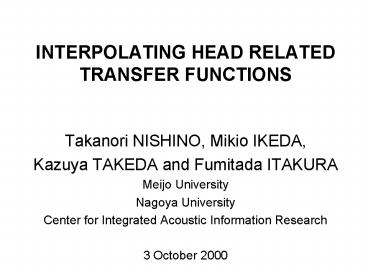INTERPOLATING HEAD RELATED TRANSFER FUNCTIONS - PowerPoint PPT Presentation
1 / 23
Title:
INTERPOLATING HEAD RELATED TRANSFER FUNCTIONS
Description:
Stimulus White noise ( 200 ms ) Azimuth 0 , 30 ,..., 330 Elevation -15 , 15 ... Stimulus White noise ( 200 ms ) Elevation -35 ,0 ,35 ,70 Azimuth 180 ... – PowerPoint PPT presentation
Number of Views:59
Avg rating:3.0/5.0
Title: INTERPOLATING HEAD RELATED TRANSFER FUNCTIONS
1
INTERPOLATING HEAD RELATED TRANSFER FUNCTIONS
- Takanori NISHINO, Mikio IKEDA,
- Kazuya TAKEDA and Fumitada ITAKURA
- Meijo University
- Nagoya University
- Center for Integrated Acoustic Information
Research - 3 October 2000
2
INTRODUCTION
- Interaural Time Difference
- Interaural Level Difference
- Reverberations
- Doppler Effect
3
3D SOUND LOCALIZATION
- Head Related Transfer Functions (HRTFs)
- Depend on the source directions
- horizontal and vertical
- The 3D audio systems based on the HRTFs need the
combination of a large number of different HRTFs
4
PREVIOUS WORK
- The use of linear interpolation
- (E. M. Wenzel and S. H. Foster, 1993)
- HRTFs were interpolated at the intervals of
30azimuth and 36 elevation - Up-down confusions were increased
5
PURPOSES
- To investigate
- the minimum number of measured HRTFs
require for interpolation, - the optimal arrangement in the horizontal and
vertical directions
6
OVERVIEW
- HRTF measurement conditions and equipment
- Experiments
- Subjective tests
- Conclusions
7
MEASUREMENT
- Turn Table (Azimuth)
- Minimum Moving Angle 1
- Accuracy 0.3
- Arched Traverse (Elevation)
- Minimum Moving Angle 1
- Accuracy 0.3
- Range from 50 to 90
8
Measurement Conditions
Two Head-and-Torso Simulators Sampling
Frequency 44.1 kHzFilter Length 512 point
(11.6ms)Azimuth 72 (0, 5,,
355)Elevation 28 (-45, 40,, 90)
9
BACK
FRONT
10
INTERPOLATION
11
EXPERIMENTS
- Experimental Conditions
- Azimuth Intervals of 45
- Elevation (1) Equally-spaced (10,15,30,45,90
) - Elevation (2) Optimal (from 3 to 6 elevations)
12
(No Transcript)
13
OBJECTIVE MEASURE
- Spectral Distortion
14
RESULTS
15
- The SD is about 3 dB when 41 directions are used
- The linear method is superior to the spline
method when the number of HRTFs is decreased - There is no significant difference between the
equally-spaced and the optimal cases
16
SUBJECTIVE TESTS
- HRTFs for evaluation
- Interpolation Method Linear Interpolation
- Number of Directions 41
- Azimuth 8 (0,45,,315)
- Elevation 6(-45,-30,0,,90)
- Phase Minimum phase with interpolated pure
delay
17
SUBJECTIVE TESTS (Azimuth)
Stimulus White noise ( 200 ms )Azimuth 0,
30,, 330Elevation -15, 15Subject 4
Subjects
18
RESULTS
Measured HRTFs (63.6 Correct)
Interpolated HRTFs (57.8 Correct)
- No significant difference between the measured
and interpolated HRTFs
19
SUBJECTIVE TESTS (Elevation)
Stimulus White noise ( 200 ms )Elevation -35,0
,35,70Azimuth 180Method The paired
comparison method (Referenced elevation is the
horizon)Subject 3 Subjects
20
RESULTS
- Interpolated HRTFs
Measured HRTFs
21
CONCLUSIONS
- Effective method of interpolating HRTF is
investigated - From objective tests,
- Linear interpolation is more effective
- The SD is about 3 dB when the HRTFs are
interpolated from 41 directions - No significant difference between the
equally-spaced and the optimal cases
22
CONCLUSIONS
- From subjective tests,
- Good performance is obtained in azimuth
- All elevations are perceived correctly
23
HRTF DATA
- URL
- http//www.itakura.nuee.nagoya-u.ac.jp/HRTF/
- Contents
- HRTFs used in this experiment
- Over 50 subjects HRTF in the horizontal plane






























